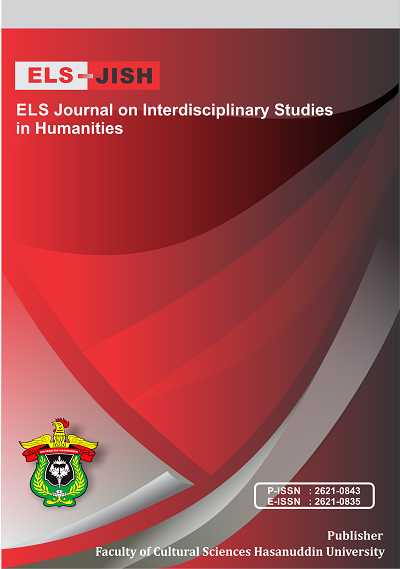Semantic Relations of Papuan Indonesian Dialect
DOI:
https://doi.org/10.34050/elsjish.v5i3.22523Keywords:
Semantic, Lexical Relations, Meaning Properties, Papuan Indonesian DialectAbstract
This study aims to investigate semantic meanings which include lexical relations and meaning properties in Papuan Indonesian dialect. It used natural data obtained in conversations among 6 Papuan students who studied at Khairun University. These participants were selected purposively considering the variety of their ethnicities and their membership in Papuan students’ community. The data were collected in three steps: interview, observation, and documentation. The data were then analysed qualitatively to elicit the dominant semantic meanings in the utterances. There are two lexical relations identified: synonymy and polysemy. The synonyms in the Papuan Indonesian dialect are influenced by the intensity of use in society, taken from other language terms, and the description of the meaning of the word. For meaning properties, two types are found: ambiguity and redundancy. The Papuan Indonesian dialect contains a lot of redundancy, that is, the use of particle language in terms of semantics does not make a difference in meaning. This study also found that based on its semantic relations, Papuan Indonesian dialect is also influenced by several factors, namely: (1) administrative unity; (2) similarity in geographical area; (3) special community identity; and (4) historical experience.
References
Antonios, M. (2016). Peran Semantis Verba Bahasa Abun. Jurnal Kandai, 12(1):17-37.
Bolinger, D. (1968). Aspect of language. New York: Harcourt Brace Javanovich Inc.
Chaer, A. (2003). linguistik umum, Jakarta: PT. Asdi Mahasatya.
Chaer, A. (2013). Pengantar Semantik Bahasa Indonesia. Jakarta: Rineka Cipta. Dependiknas.
Jefri, D.A. & Samuel, M.S. (2014). Masyarakat Hukum Adat dan Hak Ulayat di Provinsi Papua Barat sebagai Orang asli Papua ditinjau dari sisi Adat dan Budaya; Sebuah kajian etnografi kekinian. Jurnal Administrasi Publik.
Kridalaksana, H. (2008). Kamus Linguistik (Edisi ke-4). Jakarta: Gramedia Pustaka Utama.
Leech, G. (1981). Semantics the study of meaning (2nd ed). New York: Penguin Books.
Lyons, J. (1977). Semantics. Cambridge: Cambridge University Press.
Miles, M.B., & Huberman, A.M. (2005). Qualitative Data Analysis (terjemahan). Jakarta: UI Press.
Moleong, L.J. (2007). Penelitian Metodologi Kualitatif. Bandung: Remaja Rosdakarya.
Saleh, F., Rahman, F., & Hasyim, M. (2021). Metaphor in the Bugis Language Expression of the Sidenreng Dialectin South Sulawesi. International Journal of Arts and Social Science, 4(1), 312-318.
Sugiarto, Eko. (2017). Menyusun Proposal Penelitian Kualitatif : Skripsi dan Tesis. Yogyakarta: Suaka Media.
Sukmawaty, F. F. R., & Andini, C. (2022). Covid-19 Pandemic and Axiology of Communication: A Study of Linguistic Phenomena. IJISRT, 7(4).
Syamsurrijal, B. A., Makka, M., & Rahman, F. (2019). Indirect Meaning of Tembang Dangdang Gule Saking Sunan Bonang in Sasak Wedding Ceremony. International Journal of Science and Research (IJSR), 8(10), 954-959.
Palmer. F. R. (1976). Semantic a New Outline. Cambridge: Cambridge University Press.
Warami, H. (2017). Papua dalam Jejaring Bahasa Politik dan Politik Bahasa: Studi Kasus UU Otonomi Khusus Papua. Litera Jurnal Bahasa dan Sastra, 3(1): 45-53.
Yule, G. (2010). The study of language (4th ed). Cambridge: Cambridge University Press.
Downloads
Published
How to Cite
Issue
Section
License
Copyright (c) 2022 Juana Juvita, Farida Maricar, Sunaedin Ode Mulae

This work is licensed under a Creative Commons Attribution-NonCommercial-ShareAlike 4.0 International License.






